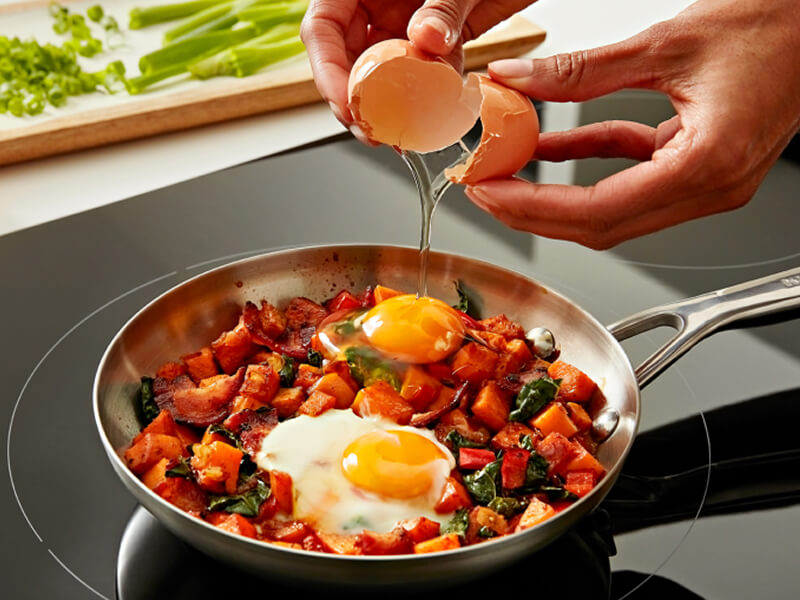
What is an induction cooktop?
Induction cooking can be described as “the best of both worlds” because not only are induction cooktops sleek and easy to clean like smooth top or glass top electric cooktops, but they also provide the accuracy and control of gas cooktops.
Read on to discover what an induction cooktop is, the advantages of using one and how induction cooking works. Explore various induction cooktops or a more comprehensive cooktop buying guide to find out what to consider when purchasing an induction or other type of cooktop.
What is an induction cooktop?
An induction cooktop is a stovetop that uses electromagnetic energy to interact with compatible pots and pans and turns them into their own heat source. This electromagnetic current passes through coiled copper wire underneath the surface of the cooktop and creates a magnetic current within the cookware, heating it up.


How does an induction cooktop work?
When you turn your cooktop on, a current begins to flow through a copper coil under the ceramic glass, creating a magnetic field around it. When an induction compatible pot is placed on the cooktop, the magnetic field creates electrical currents inside the pan, turning the cookware into a “heater.”
One of the most significant benefits of this type of electric cooktop is that it produces a rapid rise and fall in temperature. So not only will food and water come to temperature quickly, the cooktop cools off rapidly when the pan is removed from the surface.


What are the benefits of an induction cooktop?
Some induction cooktop benefits include responsive temperature control, quick cooking times and easy cleanup since the surface doesn’t get as hot. Additionally, these cooktops may reduce heat loss while cooking since the heat is created directly within the cookware and isn't transferred from a heating element through the cooktop surface.
1. Increased responsiveness
Induction cooktops cut out the added step of first heating up the heating element that then heats up the cookware. Instead, the electromagnetic currents heat up the pan itself, which leads to fast changes in temperatures for more precise cooking.
2. Precision control
Induction cooktops heat up the entire bottom surface of the pan quickly and they have fast response times to temperature change, so you can often go from a boil to a simmer in a shorter amount of time.
Some induction cooktops automate parts of the cooking process so you’re free to focus on other aspects of creating. For instance, Temp Cook™ Smart Presets on select KitchenAid® induction cooktops set and hold the ideal temperature for popular cooking methods and alert when to add ingredients, so you can perfectly sear salmon, gently simmer sauces and quickly boil water. Pairing the KitchenAid® App with these cooktops lets you unlock specialized options like stir-fry, melt, chicken cutlet and more.1
1. Wi-Fi & App required. Features subject to change. For details and privacy info, visit KitchenAid.com/Connect (U.S.) or KitchenAid.ca/Connect (Canada).
3. Flexible cooking zones
Induction cooktops can come equipped with flexible cooking zones that can accommodate large or oddly shaped cookware, and may feature zones that can help you cook two unique dishes at different temperatures, all at once.
Select KitchenAid® induction cooktops, for instance, feature the Even-Heat™ Zone that adds versatility to cook with large pans, like griddles, grill pans and braising pans, or two pans at two different temperatures. Unlike traditional round bridge elements with heating gaps, the rectangular zone heats evenly edge-to-edge, so the crepe in the back cooks just as beautifully as the one in the center.
4. Flush installation
Not every model offers flush installation, but you can likely find induction cooktops that are designed to sit flush with the countertop for a more streamlined, sleek aesthetic. For instance, select KitchenAid® induction cooktops offer a Frameless Design that allows flush installation for a seamless look, or standard installation to fit an existing cooktop cutout.

KitchenAid® POWER BOOST FUNCTION
Get extra heat when you need it
Select KitchenAid® induction cooktops with the Power Boost Function let you ramp up the heat for short periods of time so you can start creating your favorite recipes faster
5. Energy efficiency
Little to no heat is generally lost between the cooktop surface and your food during induction cooking, thanks to the electromagnetic energy that heats cookware directly and helps you create more efficiently.
6. Cooler cooktop surface
Induction cooktops keep the area around the pan relatively cool, even while you’re whipping up your favorite dishes. The surface also cools down quickly once you’ve removed cookware from the stovetop, adding convenience when you’re working quickly or have other busy cooks navigating the kitchen.
7. Easy cleanup
Since the surface of an induction cooktop does not generate its own heat, it stays relatively cool compared with a radiant electric cooktop. If spillage occurs when cooking your favorite sauces or meals, the cooler surface can help reduce baked-on, charred spills or burnt-on grease stains. Some heat can transfer from the pans to the cooktop, so be sure to allow the cooktop to cool completely before cleaning. Follow the steps for how to clean an induction cooktop in this helpful guide to help keep your cooktop looking and performing at its best.
Shop KitchenAid® induction cooktops with WipeClean™ Coating
KitchenAid® induction cooktops with the WipeClean™ Coating eliminate scraping, intense scrubbing and harsh cleaners, making this the easiest induction cooktop coating to clean.2 Just wet the surface with water and wait five minutes to easily wipe up splatters and spills.
2. When compared with a cooktop with the same heating technology at similar power output.


Are there any disadvantages to induction cooking?
While there are quite a few advantages to using an induction cooktop, it may not be the right choice for everyone. There are a few things to keep in mind with induction cooking, including the need for compatible cookware, getting used to a new style of cooking and some unfamiliar sounds coming from your cooktop.
1. May need to replace cookware
Because the electromagnetic waves have to interact with certain types of metal in order to heat up, you'll need to use cookware made of metals like cast iron, steel, or pots and pans that state they are induction ready.
However, if you want to see if your existing cookware can be used for induction cooking, you can perform a simple test. Simply flip your pan over, and place a magnet on the bottom of the pan. If it sticks, then the pan is ferromagnetic and can likely be used for induction cooking.
2. Learning curve
If you're new to induction cooking technology, it may take a little time to master the nuances of your cooktop. Keep in mind that induction cooktops are highly responsive and can heat up or cool down quickly.
3. Unfamiliar sounds
You may notice a buzzing or humming sound coming from your cooktop when using it on a higher setting, as well as the sound of the fan that cools the electronics. To help reduce noise, you can use heavy, flat-bottomed pans.
Induction cooktop vs. electric cooktop
Both electric and induction cooktops offer sleek, smooth surfaces that are easy to clean, but electric cooktops operate a little differently than induction cooktops. Radiant electric cooktops use infrared energy to heat an element, which in turn heats the pan holding your food, while induction heats the pan directly. Unlike induction cooktops, electric cooktops take a bit longer to cool off. KitchenAid® electric cooktops come in a range, from 2-burner or 5-burner options.
When deciding whether an electric or induction cooktop is best for you, here are a few things to consider:
Induction cooktops heat pans quickly, which might change your natural cooking rhythm. Getting everything prepped and ready to go before you turn on a heating zone is important when it comes to induction cooking. Explore more about the benefits and “how-tos” of mise en place cooking.
- Induction cooktops may produce operational sounds that you’re not used to hearing on other cooktops, including a low humming noise when cooking at high power, a crackling sound when using cookware that consists of different materials not compatible with induction and a fan noise that often comes from a temperature control feature.
Induction cooking tip: Cooktop care
Use soap, water and a soft cloth or sponge to clean your cooktop. To avoid damage, don’t use bleach, abrasive cleansers, steel wool or rust removers on your induction cooktop. Always wipe with a clean, wet cloth or sponge and dry thoroughly to help avoid streaking and staining. Cooktop cleaner is recommended for regular use to cut through tough, cooked-on residues and for a streak-free, polished shine, while a cooktop scraper, such as this one from Kitchenaid brand, is recommended for helping to remove stubborn spills.


Induction cooktops vs. gas cooktops
Gas cooktops are popular because of the responsiveness they bring to cooking. A natural gas or propane flame is the heat source used by gas cooktops. A flame ignites when the burner is turned on and immediately starts heating the cookware that in turn heats your food.
When deciding whether a gas or induction cooktop is best for you, here are a few things to consider:
Induction cooktops deliver accuracy and control similar to gas cooktops.
Since induction cooktops deliver similar results, they can be a good alternative if you have an interest in a gas cooktop but don't have an existing gas hookup. Learn more about how to install a cooktop.
- The smooth, quick-to-cool cooking surface gives induction cooktops an edge in cleaning ease over most gas cooktops.
- If you prefer to use an open flame for cooking techniques such as those used with a wok, a gas cooktop might be a good choice for you.
Discover more about the different cooktops available to zero in on one that matches your making. Browse the full selection of induction cooktops, electric 4-burner cooktops and gas downdraft cooktops from KitchenAid brand to find the best fit for your kitchen.


Do you have to use special pans for induction cooktops?
You’ll want to use pots and pans that are labeled as induction compatible or are made from metals like cast iron or steel. Use the magnet test mentioned above to see if your existing cookware can be used on an induction cooktop.
If you do need to replace them, KitchenAid brand offers induction compatible cookware designed to heat evenly for a deliciously executed meal.
Can you use stainless steel on induction?
You can use most types of stainless steels on an induction cooktop. However, if you’re not sure if your stainless steel cookware is compatible, take a magnet and stick it to the bottom of the pots and pans. If the magnet has a strong pull then you can likely use it for induction cooking.

